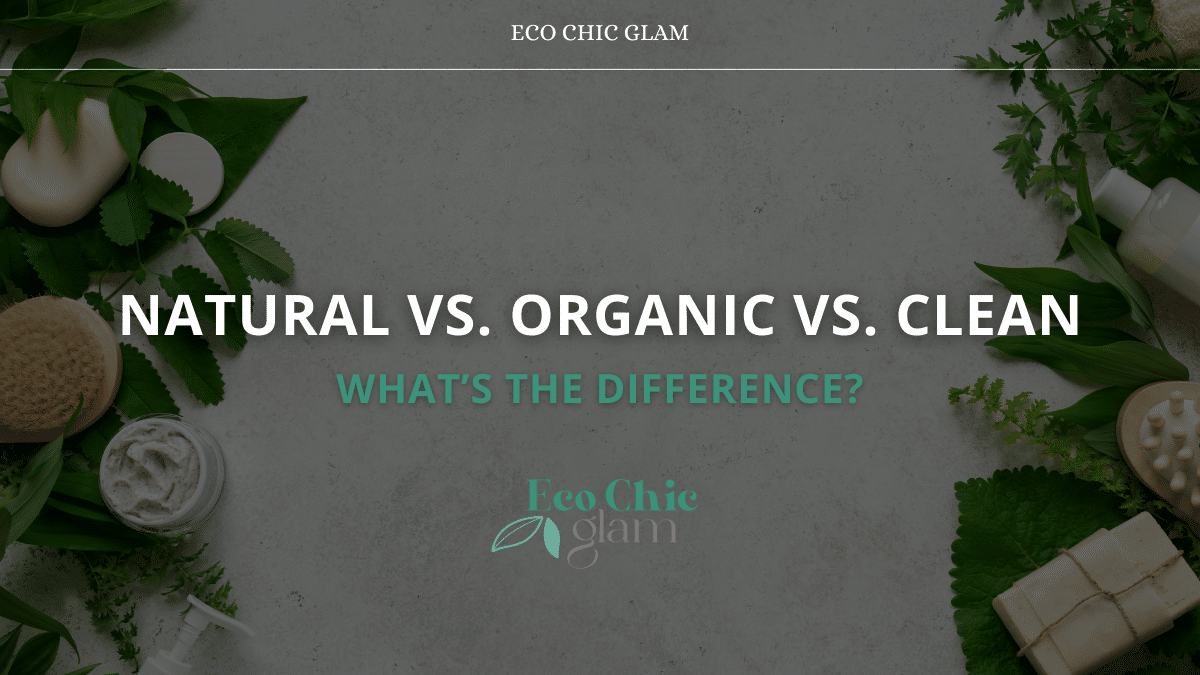You see it on every beauty label: natural, organic, clean.
They all sound good—but do you really know what they mean?
Truth is, many brands use these buzzwords to grab attention without offering clarity.
So let’s break it down—in plain language. ✨
Here’s everything you need to know about natural vs. organic vs. clean beauty—so you can shop smarter and greener.

🌿 What Does “Natural” Mean?
Natural means the ingredients come from nature—plants, minerals, or animals.
✔️ Sounds great, right?
Well… there’s a catch.
🔍 It’s not regulated.
Any product can claim to be “natural,” even if it contains synthetic ingredients or harmful additives.
✅ Pros:
- Can include plant-based goodness like aloe, chamomile, and jojoba oil
- Often free of artificial colors or fragrances
❌ Watch out for:
- Lack of transparency
- “Greenwashed” labels that include just one natural ingredient
🧠 Bottom line: Natural isn’t bad—but it isn’t always clean or safe either.
🌱 What Does “Organic” Mean?
Organic takes things a step further.
It means the ingredients were grown without:
- Pesticides
- GMOs
- Synthetic fertilizers
- Hormones or antibiotics (if animal-based)
✅ Pros:
- Better for the planet
- Lower risk of residue or toxins
- Certified by agencies like USDA Organic or COSMOS
❌ Watch out for:
- Confusing labels (e.g., “Made with organic ingredients” ≠ fully organic)
- Not all organic products are gentle or effective for every skin type
🧠 Bottom line: Organic = high-quality + eco-conscious. Look for third-party certification for proof.
🧼 What Is “Clean” Beauty?
“Clean” is all about what’s not inside.
Clean beauty avoids ingredients that are:
- Toxic
- Hormone-disrupting
- Harsh or irritating
Think parabens, phthalates, sulfates, synthetic fragrances, and more.
✅ Pros:
- Safer, gentler formulas
- Prioritizes skin health + environmental impact
- Often cruelty-free and transparent
❌ Watch out for:
- No global standard (brands define it their own way)
- Not always 100% natural or organic
🧠 Bottom line: Clean beauty is ingredient-focused and ideal for sensitive skin or wellness-minded routines.
🧪 Quick Comparison Table:
| Term | Source | Regulated? | Key Focus |
|---|---|---|---|
| Natural | Plants, minerals | ❌ No | Nature-based ingredients |
| Organic | Certified farming | ✅ Yes | No pesticides/chemicals |
| Clean | Synthetic & natural | ❌ No | Ingredient safety + transparency |
🙋♀️ FAQs
Q1: Is clean beauty better than natural or organic?
Not necessarily. Each has its strengths. Clean beauty focuses on safety, organic focuses on farming practices, and natural focuses on sources. The best choice depends on your skin and values.
Q2: Can a product be clean and synthetic?
Yes! Some synthetic ingredients are safer and more stable than their natural counterparts. Clean doesn’t mean 100% natural—it means non-toxic and non-irritating.
Q3: How can I know if a brand is being honest?
Check for full ingredient transparency, third-party certifications (like USDA, COSMOS, EWG), and detailed sourcing info. If a brand is vague—it’s a red flag.
💚 Final Thoughts: Labels Don’t Matter as Much as Ingredients
Natural, organic, clean—they’re just labels.
What really matters is knowing what’s in your products and how they affect your skin and the planet.
The more you know, the better your glow. ✨
📲 Stay Connected
✨ Follow us on social media for more clean beauty deep-dives, DIY tips, and zero-waste swaps
🌱 Visit EcoChicGlam.com for expert reviews, ingredient guides, and eco-friendly skincare that works

